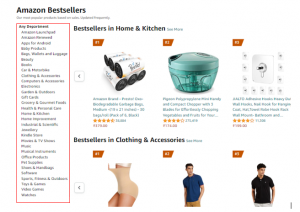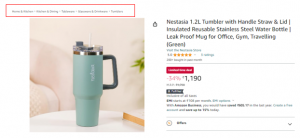In the vast landscape of e-commerce, Amazon stands tall as a global giant, connecting millions of buyers and sellers every day. If you're considering venturing into the world of online retail, Amazon is undoubtedly a platform worth exploring.
One of the burning questions that often perplexes aspiring entrepreneurs is, “What type of products can I sell on Amazon?” In this comprehensive guide, we will unravel the diverse tapestry of Amazon's product categories and help you identify the right niche for your business.
Amazon's vast marketplace is renowned for its inclusivity. From everyday essentials to niche products, the platform accommodates a plethora of items. This inclusivity stems from Amazon's commitment to providing customers with a one-stop-shop experience, making it an attractive platform for sellers.
While Amazon is all-encompassing, finding success often involves identifying a profitable niche. Understanding the demands and preferences of your target audience can guide you in selecting products that not only align with market trends but also resonate with potential buyers.
Choosing a product is the most time-consuming and important part of starting a highly successful online business. In this lesson, I am going to explain the process to you in a much simpler way by just following these 5 features of an excellent product.
5 Features of an Excellent Product:
Let's start with the basics. Conducting product research is crucial, but before you begin your search, it's essential to have a clear understanding of what makes a product truly exceptional. In other words, discovering what features a product must have to be awesome!
These are the characteristics I hunt for while researching my products:
Criteria1: The selling price should be between Rs.500 and 1,500
It's crucial to focus on selling a product within the price range of Rs.500 to 1,500 on Amazon. The rationale behind this range is twofold:
- Below 500: Selling products priced below 500 may lead to minimal profit margins. After factoring in the costs from the manufacturer, Amazon's commission, courier expenses, and taxes, the remaining profits can be significantly diminished. Therefore, it's advisable to avoid selling items with a ticket price below Rs.500.
- Above 1,500: Products priced above 1,500 tend to undergo more extensive scrutiny from potential buyers. Higher-priced items prompt customers to engage in thorough research, compare prices across various websites and invest more time in decision-making. This extended decision-making process can pose challenges for sellers. To streamline the buying process and encourage quicker decisions, it's recommended to focus on products within the 500 to 1,500 price range.
By adhering to this pricing strategy, sellers can strike a balance, ensuring sufficient profit margins while catering to the preferences and behaviors of online shoppers.
Criteria 2: Reviews on a product page
The number of reviews and ratings on a product page should ideally be less than 500. The rationale behind seeking products with fewer than 500 reviews is rooted in the competitive landscape. When a product has a lower number of reviews, it becomes more manageable for sellers to compete against them. Attempting to compete with listings that boast 10,000 or 20,000 reviews can be challenging.
Furthermore, if you examine a product page, such as the example with 106 reviews, it might seem promising. However, if the price is significantly lower, it may not align with the desired criteria. On the other hand, another example with higher reviews (3,400) might not be suitable, but if the price meets the criteria, it could still be considered.
In essence, finding the right product involves balancing multiple criteria. Two crucial factors are the selling price and the number of reviews, both of which play integral roles in determining the viability and competitiveness of a product in the market.
Criteria 3: Weight of the product
Ideally, the weight should be less than 1 kilogram, and the product itself should be small and lightweight. Why the emphasis on a weight below 1 kilogram and a small size? The rationale is rooted in the logistics of shipping. When shipping products to customers using a courier service, charges are determined based on the weight of the package. Products weighing more than 1 kilogram incur significantly higher courier charges, almost double the cost.
For instance, shipping a product weighing less than 1 kilogram might cost approximately 80 to 100 rupees, while shipping a product weighing more than 1 kilogram could result in charges ranging from 160 to 200 rupees.
To optimize costs and prevent unnecessary expenses on shipping, it's advisable to identify products that are not only small but also lightweight. In terms of size, a product smaller than a shoebox is ideal. Checking the product page on Amazon and scrolling down to the product details section will reveal the item's weight.
Another example is that an item with a weight of 349 grams aligns well with these criteria, while a product weighing 4 and a half kilograms falls outside the desired range. Therefore, weight becomes the third crucial factor in product selection.
Criteria 4: Branding Potential
Branding potential can be understood through a simple question: If you were to buy a vegetable chopping board, which brand comes to mind? The responses often include popular names like Anjali and Prestige. Similarly, when it comes to toothpaste or mobile phones, brands like Colgate, Pepsodent, Samsung, MI, and Apple quickly come to the forefront.
However, if the question shifts to lesser-known products like a cake turntable or a garbage bag, the responses become less definite. This highlights products with high demand but no dominant brand association.
This lack of brand preference signifies branding potential—a space where a product can be introduced and branded successfully. In these instances, consumers are not fixated on a specific brand, presenting an opportunity to build and establish a brand around such products.
So, why build your brand? There are several compelling reasons. Firstly, having your brand allows for greater control over pricing. No one else can sell the same product under your brand name and undercut the price. This control over pricing is a significant advantage.
Secondly, the concept of the “buy box” on Amazon comes into play. The buy box is a prominent feature on product pages that determines which seller's product is displayed when a customer clicks “Add to Cart” or “Buy Now.” By having your own brand, you become the sole seller of that product, eliminating competition within the buy box.
Furthermore, building a brand creates a tangible asset with long-term value. This asset can be passed down to future generations or sold for a substantial sum in the future. Over time, as customers recognize and trust your brand, they are more likely to make repeat purchases. Customer loyalty is a key benefit of brand building.
To dispel any misconceptions, creating your brand is not as challenging as it may seem. Essentially, it involves imprinting your logo on the product. Whether it's a lunch bag, a spice tray, a car cleaning brush, or a vegetable chopping board, the process is straightforward—place your logo on the product. Building a brand is about simplifying this process and making your mark on the products you sell.
Criteria 5: The best seller rank should be 200 to 2000
So, what exactly is the Best Seller Rank (BSR)? Amazon assigns a rank to every product it offers, providing a clear indication of which products are selling the most. This rank is prominently displayed on each product's Amazon page. The lower the number, the higher the sales for that particular product.
To draw a parallel, think of it like school rankings, where the top-ranked student is the highest achiever. Similarly, in Amazon's Best Seller Rank, the product with the lowest rank is the best-selling one. Now, you might wonder why not choose a product from the top 1 rather than from 200.
The rationale behind this lies in the fact that if you pick a product within the top 1 to 199, it attracts more attention and, consequently, more competition. On the other hand, if you opt for a product with a rank exceeding 2000, it signifies lower demand. The sweet spot, therefore, is between 200 and 2000.
To find products within this range, simply go to Google and search for “Amazon Bestseller India.” Click on the provided link, and you'll discover 30+ categories ranging from baby and beauty to clothing, accessories, and more. Amazon displays the top 1 to 100 sellers in each category. The key is to focus on products with ranks between 200 and 2000.
During this process, it's crucial to explore the main categories rather than subcategories. While Amazon might show ranks for subcategories, concentrate on the top-level category to make informed decisions. To illustrate, follow the below steps:
- Start by searching for “Amazon Bestseller India” on Google
- Click on the link, usually resembling “amazon.in/GP/bestsellers”
- Choose a category in which you're interested
- To explore products beyond the top 100, click on a subcategory within the main category
- Analyze products in the subcategory based on criteria like price, reviews, and Best Seller Rank to identify potential opportunities
By adhering to the criteria of a price between 500 and 1500, reviews below 500, and a Best Seller Rank between 200 and 2000, you can pinpoint products with optimal selling potential. This approach helps you strike a balance, ensuring a product isn't oversaturated with competition while maintaining sufficient demand.
In conclusion, while the best products to sell on Amazon may vary based on trends and consumer behavior, success ultimately hinges on thorough market research, effective marketing strategies, and a commitment to delivering quality products.
You can choose to delve into any category; the key is to stay adaptable, customer-focused, and abide by Amazon's guidelines. By doing so, you can position yourself for a rewarding and prosperous journey in the thriving e-commerce landscape that Amazon provides.


